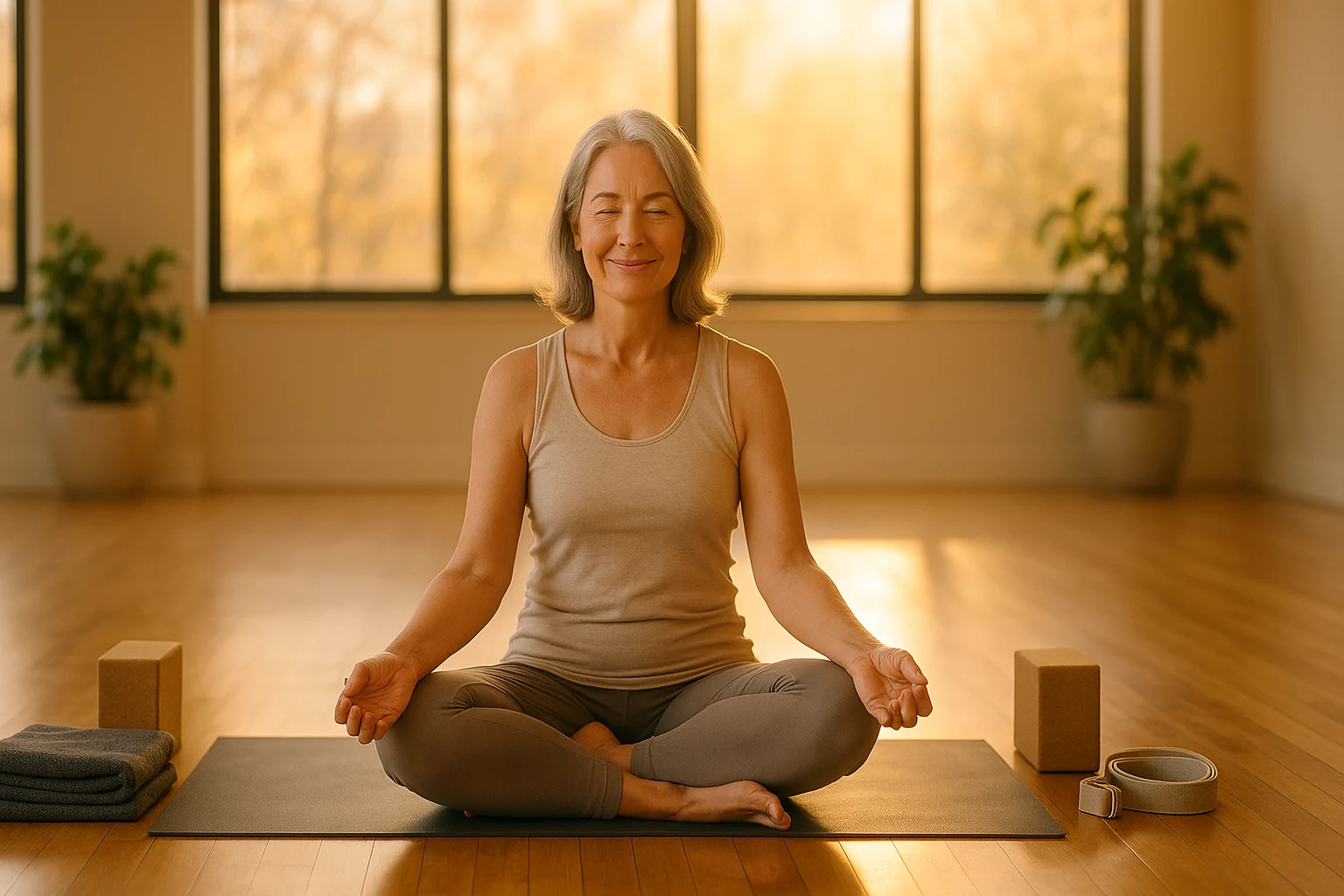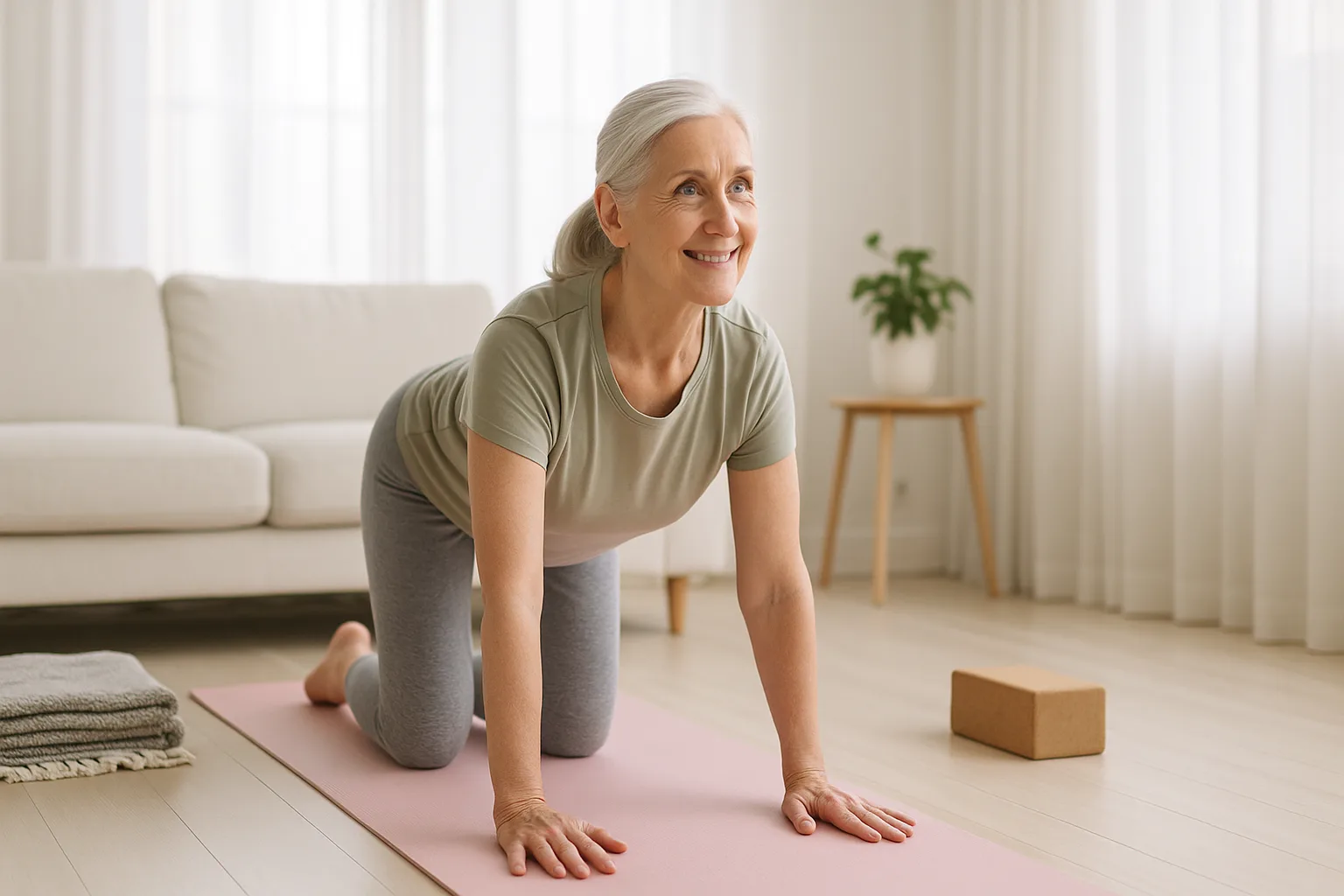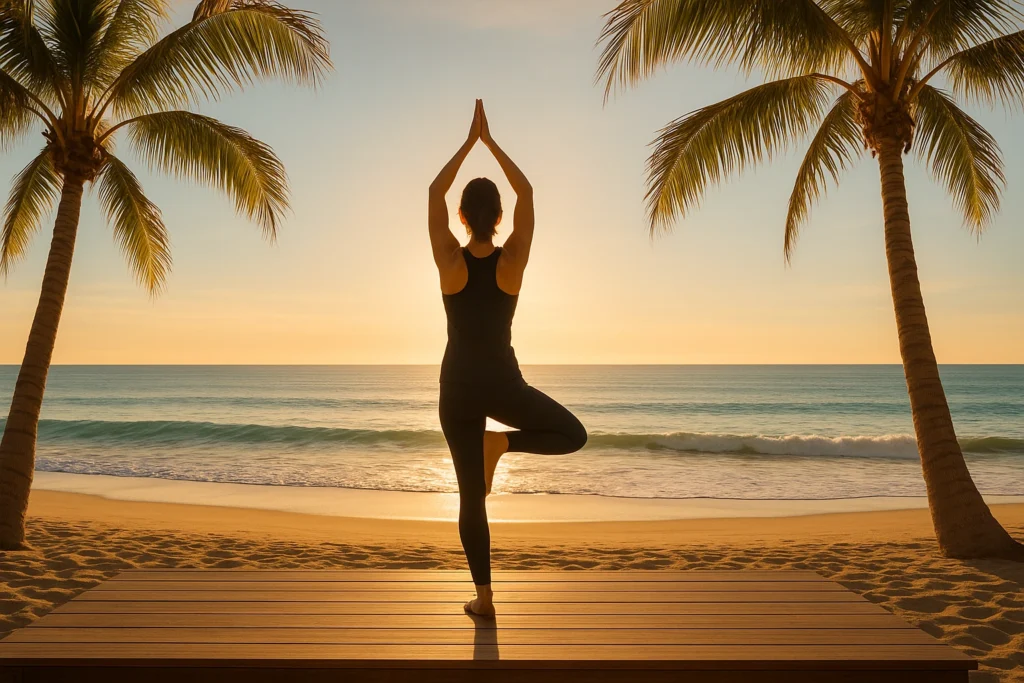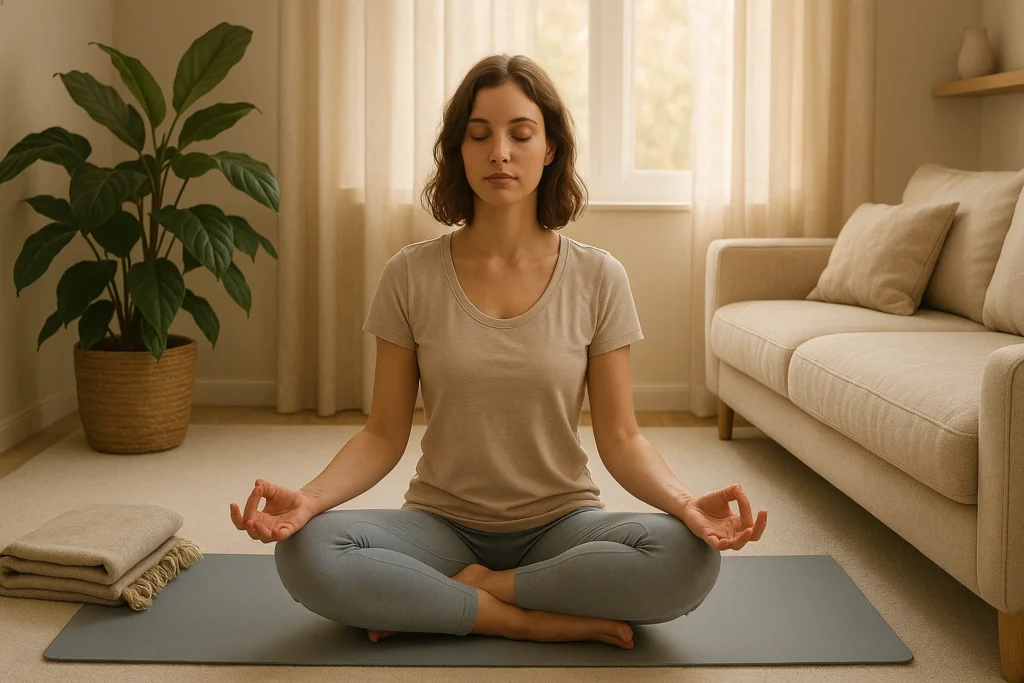
Struggling with stiff joints? Yoga for arthritis can help—sometimes in as little as 10 minutes a day. If walking upstairs or opening jars feels daunting, this gentle approach reduces stiffness, builds flexibility, and adds a little calm back into your day. Unlike intense workouts, it blends mindful movement, breathing, and relaxation to support your joints. In this guide, you’ll find safe poses, easy breathing techniques, and practical tips to make moving feel better with yoga specialized health — our comprehensive pillar guide.
What Is Arthritis and How Yoga for Arthritis Helps
Arthritis affects one or more joints and can cause pain, stiffness, swelling, and limited movement. Osteoarthritis develops as cartilage wears down, while rheumatoid arthritis is an autoimmune attack on joint tissues. While there’s no cure, a gentle yoga practice can help ease symptoms by gently moving synovial fluid and strengthening the muscles that support your joints. According to the Arthritis Foundation, regular practice may reduce joint pain for some people.
Osteoarthritis vs. Rheumatoid Arthritis
Osteoarthritis (OA): Often called “wear and tear,” it happens as cartilage thins over time, usually in the knees, hips, or hands. Gentle yoga builds the surrounding muscles so those joints carry less load.
Rheumatoid Arthritis (RA): An autoimmune disease in which the immune system targets the joints, causing inflammation. Restorative poses and steady breathing may help you move with less irritation.
Why Yoga for Arthritis Works
Why does this help so many people with arthritis? It tackles several issues at once and supports overall joint health. Here’s the short list:
- Increased Flexibility: Gentle stretches lengthen muscles and free up stiff joints, so everyday tasks feel easier.
- Reduced Stiffness: Regular movement prevents joints from locking up, easing morning discomfort.
- Stronger Muscles: Poses build muscle support around joints, enhancing stability, especially for knees and hips in osteoarthritis.
- Better Balance: Arthritis can impair coordination, but yoga may improve balance, which could help lower fall risk.
- Pain Management: Mindful movement and breathing can shift how your brain perceives pain.
- Stress Relief: Chronic pain fuels stress, which worsens inflammation. Yoga’s relaxation techniques may help lower stress.
- Improved Posture: Yoga strengthens core muscles, reducing joint pressure through better alignment.
- Enhanced Body Awareness: You’ll get better at noticing your body’s signals—so you can back off, adjust, or use props before pain ramps up.
This post has affiliate links. We may earn a commission. Learn more.
Safety Tips Before You Start
Before you start, put joint safety first. A few quick guidelines:
- Consult Your Doctor: Check in with your clinician first—especially if your arthritis is severe or you’ve got other conditions.
- Listen to Your Body: Discomfort is okay; sharp pain is not. If it bites, stop, reset, or swap the pose to protect your joints and muscles.
- Start Slowly: Begin with short sessions (10-15 minutes) and gradually increase as you gain comfort.
- Use Props: Blocks, straps, and blankets make poses accessible and reduce strain.
- Avoid Overstretching: Move gently without forcing or bouncing into stretches.
- Warm Up: Start with light movement to prepare your joints and muscles.
- Find an Expert: Look for a teacher with arthritis training—they’ll know the right tweaks and props for you.
What You Need to Begin
Getting started with arthritis-friendly yoga requires very little. Here’s what helps most:
- A Yoga Mat: Adds gentle cushioning and enough grip so you feel steady.
- Comfortable Clothing: Wear loose, flexible attire for ease of movement.
- Props (Recommended):
- Blocks: Support your hands or feet and bring the floor closer.
- Strap: Gives you extra reach so stretches stay easy and controlled.
- Blankets/Towels: Cushion sensitive knees or wrists.
- Chair: Great for seated or supported versions of standing poses.
- Quiet Space: A calm corner helps you focus and actually relax.
Arthritis Yoga Poses for Relief
These beginner-friendly arthritis yoga poses focus on soothing movement for sore joints. Go slow, breathe steadily, and stay within your own range.

Seated Poses for Joint Comfort
Chair Pose (Modified) 🪑
Benefits: Builds leg and core strength and steadies your balance—without overloading knees or hips. For more seated options, explore chair yoga for seniors.
How to:
- Sit tall in a sturdy chair, feet flat, hip-width apart, knees over ankles.
- Engage your core.
- Inhale, lift arms forward or overhead, keeping shoulders relaxed.
- Hold for 3-5 breaths, feeling gentle leg and core engagement.
- Exhale, lower arms. Repeat 3-5 times.
Modification: If lifting arms hurts, rest hands on thighs or press palms together at chest.
Cat-Cow Stretch (Marjaryasana-Bitilasana) 🐱🐮
Benefits: Enhances spinal mobility, can feel like a gentle abdominal massage, and may help ease back, hip, and shoulder stiffness.
How to:
- Start in tabletop (hands under shoulders, knees under hips). Use a blanket under knees for comfort.
- Cow Pose (Inhale): Drop belly, lift chest, and look slightly up without neck strain.
- Cat Pose (Exhale): Round spine, tuck chin, and relax head.
- Flow between Cat and Cow for 5-10 rounds, syncing with breath.
Modification: For wrist pain, use forearms or do seated in a chair, gently arching and rounding your back.
Yoga for Joint Pain: Restorative Poses
Thread the Needle Pose (Parsva Balasana) 🧵
Benefits: Stretches shoulders and upper back, relieves tension, and calms the mind.
How to:
- From tabletop, shift weight to right hand.
- Exhale, thread left arm under right armpit, palm up. Lower left shoulder and head to mat.
- Keep right hand for support or extend forward for a deeper stretch.
- Breathe for 5-10 breaths, then unthread and repeat on the other side.
Modification: Use a blanket or pillow under head for comfort. Avoid forcing the twist.
Supine Spinal Twist (Supta Matsyendrasana) 🌀
Benefits: Gently twists spine, stretches back and hips, and eases lower back stiffness. Learn more in our guide to yoga for lower back pain relief.
How to:
- Lie on back, knees bent, feet flat, hip-width apart.
- Extend arms in a “T” shape, palms up or down.
- Let knees fall to one side (e.g., right). Keep knees together or stacked.
- If comfortable, look opposite (e.g., left).
- Breathe for 5-10 breaths, then return to center and repeat on the other side.
Modification: Place a block or pillow between or under knees if the stretch is too deep.
Legs-Up-the-Wall Pose (Viparita Karani) 🦵⬆️🧱
Benefits: May help reduce leg swelling, stretches hamstrings and lower back, and promotes relaxation.
How to:
- Sit with one hip near a wall.
- Lie back, swing legs up the wall, keeping sit bones close to the wall.
- Use a blanket or bolster under hips for comfort.
- Rest arms by sides or on belly/heart. Relax for 5-15 minutes.
- To exit, bend knees, push off wall, and roll to side before sitting up.
Modification: If wall pose is hard, elevate feet on a chair or pillows.
Child’s Pose (Balasana) 🙏
Benefits: Stretches hips, thighs, and ankles while calming the mind.
How to:
- Start on hands and knees.
- Bring big toes together, widen knees as comfortable.
- Sink hips toward heels, folding torso forward.
- Rest forehead on mat or blanket, arms by sides or extended.
- Breathe deeply and relax. Stay as long as comfortable.
Modification: Place a blanket between seat and heels or use a block under forehead.
Breathing Techniques for Pain Relief
Breathing, or pranayama, is a cornerstone of this practice. It calms the nervous system and can make pain feel more manageable. It’s a simple form of yoga for joint pain on days when movement feels like too much. For more techniques, check out our beginner breathwork guide for anxiety relief.
Diaphragmatic Breathing (Belly Breathing)
Benefits: Activates relaxation, reducing stress-induced inflammation.
How to:
- Lie down or sit comfortably. Place one hand on chest, one on belly.
- Inhale through nose, letting belly rise while chest stays still.
- Exhale slowly through mouth or nose, feeling belly fall.
- Practice for 5-10 minutes to relax deeply.
Nadi Shodhana (Alternate Nostril Breathing)
Benefits: Helps balance your nervous system, quiet the mind, and dial down stress.
How to:
- Sit with a straight spine.
- Close right nostril with thumb, inhale through left nostril.
- Close left nostril with ring finger, exhale through right nostril.
- Inhale through right nostril, close it, exhale through left.
- Continue for 5-10 rounds.
Ujjayi Breath (Ocean Breath)
Benefits: Soothes the nervous system and helps many people feel calmer and steadier—useful during rheumatoid arthritis flare-ups.
How to:
- Sit or lie comfortably.
- Inhale deeply through your nose, gently narrowing your throat to make a soft “ocean” sound.
- Exhale through your nose with the same easy constriction.
- Practice for 3–5 minutes, focusing on the sound and rhythm.
Mindfulness for Managing Pain
Mindfulness helps you notice pain without tensing up—often taking the edge off. Try these:
Body Scan Meditation
Lie down and move your attention slowly from head to toe, noticing sensations without judging them. How are your knees today? Your hands? This simple check-in may help your body soften.
Mindful Movement
While you move, keep asking, “What do I feel right now?” If Child’s Pose feels good, stay; if not, adjust. Staying present helps you avoid fixating on pain.
Building Your Yoga Routine
Consistency beats intensity in yoga for arthritis. Here’s how to get started:
- Start Small: Try 10-15 minutes, 3-4 times a week.
- Build Gradually: Increase duration or frequency as you feel stronger.
- Adjust Daily: On flare-up days, focus on breathing or restorative poses—arthritis-friendly yoga that still helps without stress.
- Create a Habit: Pick a time that fits your day and stick with it—consistency makes the routine.
Sarah’s Journey with Yoga
Sarah, 62, lives with osteoarthritis in her knees and hands. Stairs—and even heavy books—used to feel like a chore. Skeptical but hopeful, she tried a chair-yoga class. The first sessions were clunky; even lifting her arms felt hard. With props and patience, she kept going. Within a few weeks she noticed mornings felt less stiff, she could walk a little farther, and her hands didn’t ache as much. A year later, she takes stairs with less discomfort and feels more in charge. “Yoga isn’t a cure,” she says, “but it’s given me control and comfort.” Small, steady steps added up.
Find Your Arthritis-Friendly Pose
Answer three quick questions and get a pose matched to your needs.
What type of arthritis do you have?
What’s your primary symptom?
How do you want to practice today?
When to Seek Professional Help
Yoga can help a lot, but it doesn’t replace medical care. Good next steps:
- Consult Your Doctor: Keep your doctor informed about your practice so they can tailor your care.
- Physical Therapist: They can tailor exercises to your joint needs.
- Certified Yoga Therapist: Offers personalized guidance for chronic conditions.
Frequently Asked Questions
Start Your Yoga Journey Today
Embracing yoga for arthritis can change how you manage joint pain—more comfort, more mobility, less stress. You don’t need perfect poses; just small, kind moves that feel good today. Pair gentle poses with steady breathing and many people feel looser and more confident; your experience may vary. Go slow, celebrate the small wins, and let your body set the pace.


